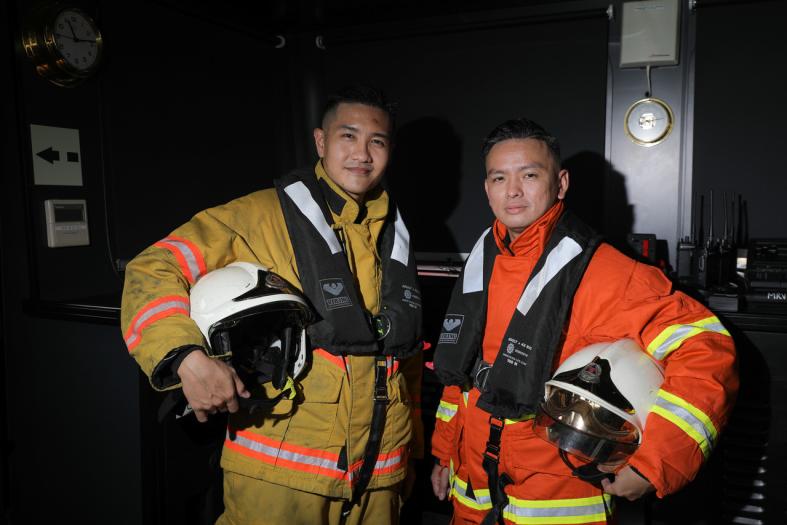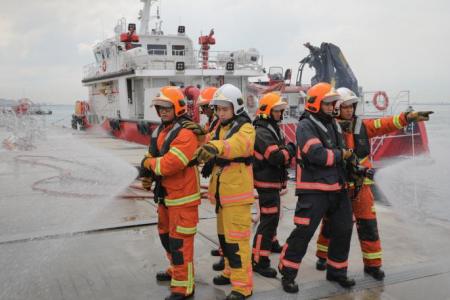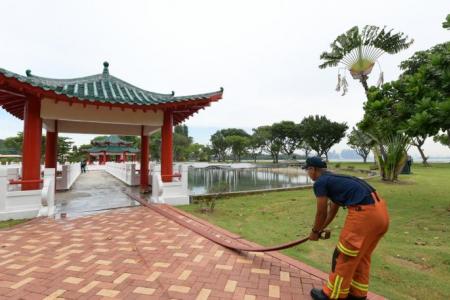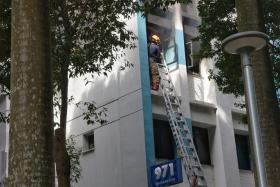Firefighters scaled 152 steps and linked 18 lengths of hoses to fight Kusu Island fire
The fire on April 17 that destroyed three shrines on a hill in Kusu Island was so intense that a blue plastic chair nearby melted.
Sergeant Jagadeeshvaran Ramanathan, who was among 17 firefighters deployed to douse the flames there, described the scene in an interview with The Straits Times on Wednesday (April 27).
It was his first time responding to a major fire, and the 29-year-old said he initially felt a sense of fear and excitement.
"It was raining really heavily, there was lightning and visibility was bad," he added.
Sgt Ramanathan, who is about a year into his full-time national service, was part of a crew of 12 firefighters on board a Singapore Civil Defence Force (SCDF) marine rescue vessel.
They operate out of the Brani Marine Fire Station, which is located on Brani Island near to Sentosa.
The blaze had engulfed three Malay shrines on top of the hill at about 6.40pm, and the team found that there were no street lights on Kusu Island or fire hydrants.
Mr Hari Haran, 26, a cleaner working on the island, had to use his buggy to ferry the hoses from the SCDF vessel to the foot of the hill.
He was the first person to see the fire and call for help.
As the firefighters scaled 152 steps up a hill to get to the blaze, they linked 18 lengths of hoses together so sea water, pumped from the SCDF vessel, could be used to extinguish the flames.
Meanwhile, the thunderstorm made the floor slippery.
Despite his initial uncertainty, Sgt Ramanathan said his training kicked in once he and his team of three reached the fire.
They were mindful that shrines were involved. Unfortunately, they could not be saved.
Their caretaker, Mr Ishak Samsudin, 60, said the shrines will have to be rebuilt.
SCDF investigations later showed that the fire was not deliberately set.
The three shrines, also known as keramat, are dedicated to a pious figure named Syed Abdul Rahman, his mother, Nenek Ghalib, and his sister, Puteri Fatimah Shariffah.
Sgt Ramanathan said his team was later joined by another five firefighters from Marina Bay Fire Station, who brought up a second set of hoses to help douse the flames.
Among them were Warrant Officer Zainul Arifin Isman, 31, and Sergeant Abu Zar Al-Ghifari Othman, 21.
Warrant Officer Arifin, who did not have time to break his fast before rushing over to the fire, said clear communication is essential between firefighters in complex and difficult conditions.

"We have to speak in clear and straightforward terms to make sure everybody is on the same page.
"I was also paying special attention to Abu Zar, as it was only his third duty after finishing his leadership course," he added.Major Landon Leong, 36, who is the commander of Brani Marine Fire Station, and Major Muhammad Shafi Rafie, 36,commander of Marina Bay Fire Station, said their stations have planned and practised for fires in the Southern Islands.

Major Leong said his firefighters are prepared for and familiar with the islands, which include recreational hot spots St John's and Lazarus Islands.
However, there had not been a fire of the scale seen on Kusu Island on the recreational islands for as long as he can remember, he added.
Mr Ishak, the caretaker, said rebuilding the shrines may cost several thousand dollars.
He added that the cost of construction on the island is nearly triple that on the mainland.

When ST visited the site the day after the fire, little was left of the shrines except the metal roofs and some rubble.
Devotees who make the trip to Kusu Island to visit the Chinese Da Bo Gong (Tua Pek Kong) Temple also spend time at the shrines, which are said to be built in the 1920s.
The temple, built in 1923, attracts thousands of devotees during an annual pilgrimage.
It takes place during the ninth month of the Chinese lunar calendar, typically between September and November.
Last year's pilgrimage period was between Oct 6 and Nov 4.
Get The New Paper on your phone with the free TNP app. Download from the Apple App Store or Google Play Store now



